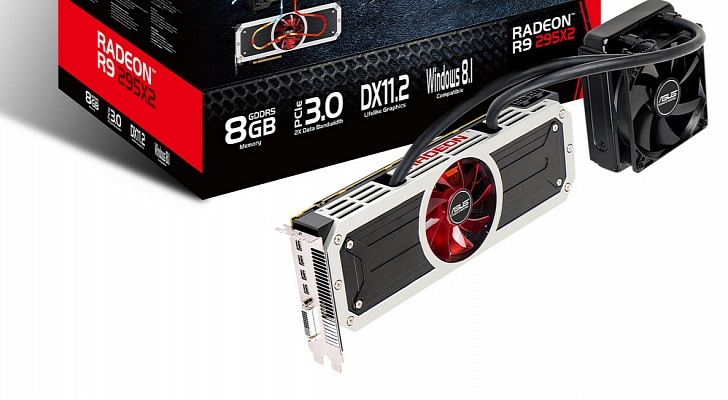Radeon R9 295X2 – 4K Graphics with two GPU liquid cooled
Aimed at gamers who are looking for record-breaking performance and uncompromising solutions with Eyefinity and Ultra HD.
Developed under the code name Project Hydra, the R9 295X2 Radeon graphics card is the new top of the range proposal by AMD in the segment of non-professional 3D products. At the time this model with dual GPU on a single PCB is the fastest on the market, in direct competition with the Sli solutions based on two GeForce GTX 780 Ti. One of the video cards Nvidia has recently announced is the Titan Z with dual GPU, but for this model the purchase price declared is more than double that shown for the AMD solution.
To ensure the stability of the two-class GPU Hawaii XT, the R9 295X2 is equipped with a hybrid cooling system that combines a fan of traditional type with a liquid circuit manufactured by Asetek. This waterblock is made of two pieces – one for single GPU – the thickness of which allowed to reduce the size of the board to only two PCI Express slots. The two water blocks are connected to a radiator with fan and overall size of 120 x 152 x 64 mm. The presence of the radiator requires careful evaluation of the space within the frame: it must be at least one rear 120mm fan or two areas dedicated to the radiators if you already have a liquid circuit for the CPU.
The traditional fan serves to cool the plate dissipation copper which is mounted above the power supply circuits and passive heat sinks that surmount the memory chips. Like all high-end Radeon cards, this one has a back plate that protects the surface mount components and helps to standardize and dissipate heat. The operating specifications that we will discuss shortly determine a set of minimum requirements for the power supply system. The card requires the use of two connectors Peg X8 on each of which the power supply must be able to provide current peaks 28A and overall a stable current equal to 50A.
At the base of the Radeon R9 are 295X2 architecture called Vesuvius, or a Crossfire configuration of two Hawaii XT GPU. These are the same products at the base of the Radeon 290x R9, that is top of the line graphics cards in a single GPU that AMD has presented at the end of 2013. The technical characteristics of the solution can be deduced by doubling those of the GPU that compose it. An exception is the operating frequency of the GPU that is 18 MHz higher than that of R9 290x thanks to the use of the system of liquid cooling and the calculation of the local memory; although the latter is actually equal to 8 Gbytes, we recall that in the multi-GPU solutions, each area of memory associated with a processor graph must contain a full copy of the data available to the other GPU and for this reason the useful memory to contain unique information is also equal to 4 GB on the Radeon R9 295X2.




